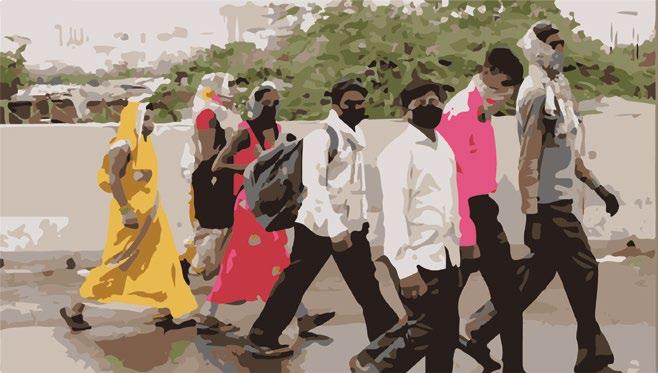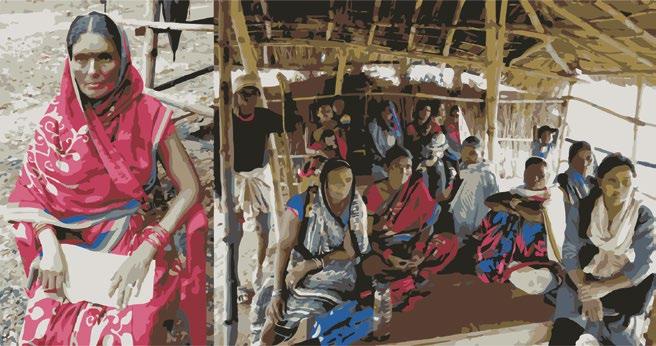
9 minute read
Assam
Family visiting the detained members in the detention camp, Assam, India. Photo: Shaheen Abdulla, Maktoob
Citizenship crisis in Assam
On August 31, 2019, the final National Register of Citizens (NRC) was released in Assam. It excluded 1.9 million people, who now along with their families face the specter of statelessness. Two other processes, the ‘Declared Foreigner’ and ‘D Voter’ process together with the NRC exclusions potentially target 2.2 million Indians and their families in all. The first draft of the NRC published in July 2018 had excluded 4 million from NRC List and although the final draft exclusion was much lesser in number, it was still a significant number. The process has been arduous and traumatic affecting religious and ethnic minorities, 69 per cent affected by this are women. Behind this much criticized process off seeking a documentary test of citizenship is the peculiar history of the North Eastern state of Assam, ethnic strife and a targeting of the linguistic and religious minorities. The purpose of the entire NRC process was to identify people who allegedly emigrated illegally from Bangladesh after 1971, when East Pakistan became Bangladesh. After much conflict the Assam Accord was signed in 1985 and this document forms the basis of the ongoing process of the NRC.
The NRC process required citizens to produce documentary evidence of residence in Assam before March 24, 1971. They required proof that either they or their ancestors were residing in India before that date. These were called legacy documents. The other set of documents were linkage documents that established person’s relationship with those ancestors. Poor history of documentation, bureaucratic hurdles, corruption and the limited resources of the economically challenged classes made documents a luxury for a large section of people. Worse still is the fact that minor name and date discrepancies have led to exclusions.2
Judicial intervention
The NRC process can be broadly divided into two stages. The first is circumstances under which the Supreme Court struck down the newly enacted Illegal Migrants (Determination by Tribunals)
Act, 1983,and the Illegal Migrants (Determination by Tribunals) Rules, 1984in the SarbanandaSonowal v Union of India case (2005,2007).3 The second phase is the Supreme Court’s role in “overseeing” the NRC process between 2008 – 2019. In SarbanandaSonowal v Union of India (decided on July 12, 2005), the Supreme Court relied upon unverified –and now disproved – data to hold that migration amounted to “external aggression” upon India. It then invoked Article 355 of the Constitution to strike down a state enacted legislation that, in accordance with broader principles of Indian criminal law, transferred the burden of proof in a case where any person is accused of not being an Indian, to the State. The Court upheld a pre-independence, colonial law and its sections –Section 9 of the Foreigners Act, 1946 –that placed the burden on the individual accused of being a foreigner. The second stage in the judicial interventions related to Citizenship in Assam is the Assam Public Works vs Union of India Case. Since 2009, Justice Ranjan Gogoi who rose to become India’s Chief Justice oversaw the case defying judicial convention.4 It was the bench led by Justice Gogoi who, in 2018 accepted the rather outrageous and controversial contention of then NRC co-ordinator Prateek Hajela who passed this Executive order: All persons born before June 30, 1987 whose either parent have been declared ‘doubtful voter’ (also a nonadjudicated process conducted by junior officials of the Election Commission of India- ECI) or ‘declared foreigner’ (through a notice served by the Assam Border Police)should also be excluded from the final NRC.5As a consequence, scores of persons who have been excluded from the final NRC are children of these doubtful voters or declared foreigners. The worst injustice and failure of due process is that a majority of these doubtful voters/declared foreigners have not even gotten a chance to defend their citizenship, and yet their children are being made to suffer the consequences of this unfair and arbitrary process. In January 2020, the SC ruled in an intervention application filed by the Mumbai-based Citizens for Justice and Peace that upholding national and international legal principles of unification of the family no child/minor would be sent to Detention Camps.6 Under the SC monitored process, Standard Operating Procedures (SOPs) were established after discussions with all stakeholders. But some concerns still remained about a disproportionately large impact on minorities and marginalized communities. Some orders by the Supreme Court (Supreme Court Legal Services Committee vs. Union of India May 10, 2019), have mitigated the situation somewhat especially when the court directed that those who have spent more than three years in detention camps in Assam be set free subject to certain conditions.7 On April 13, 2020, owing to the COVID-19 crisis, the court decided to further relax this condition and directed that people who have spent more than two years in detention may be released subject to conditions which were lenient compared to the May 2019 decision. In a space of seven months some human rights organisations managed the release of scores of detainees.8
Foreigners Tribunals
Those excluded from the NRC, those declared ‘D’ Voters or ‘Declared Foreigners’ face Assam’s dreaded
Foreigners Tribunals (FT), that have drawn criticism for allegedly not following Constitutional guarantees, principles of natural justice or evidence laws. Not only has their functioning been erroneous and widely criticised but the inefficiency of India’s judicial system is likely to threaten 2.2 million plus excluded as it would take, by one estimate, 234 years for all to navigate their appeals in the higher courts! The issue with the FTs is that they do not function independently and are not free from executive influence. Tenure and salaries are decided by the government, keeping the members under the supervision and control of the appointing authority. Moreover, twothird of the decisions are allegedly made ex-parte, and often, the main grounds are not mentioned in the notice sent by Detention Camps The consequences of being declared non-Indian is this: A person faces Assam’s dreaded Detention Camps. As of August 2020, there are 6 makeshift detention camps in Assam housed within premises of prisons. Over a year after the NRC List was declared, the specter of statelessness haunts Assam and widespread impoverishment and trauma has led to over 107 deaths, a majority by suicide.10
Legislative background
The Citizenship Act, 1955 clearly states that anyone born in India on or after January 26, 1950 up till July 1, 1987 is an Indian citizen by birth. Anyone born on or after July 1, 1987 but before the commencement of the Citizenship (Amendment) Act, 2003 and either of whose parents is an Indian citizen at the time of his birth is an Indian citizen. And anyone born after the commencement of the Citizenship (Amendment) Act, 2003 and both of whose parents are Indian citizens at the time of his birth is an
the FTs to the suspected persons.9
Indian citizen. The only exception to this was Assam where as per the 1985 Assam Accord foreigners who came to the state up to March 24, 1971 were to be regularised as Indian citizens. For the rest of the country, those born outside the country after January 26, 1950 and residing in India without proper documents is a foreign, illegal immigrant. Such persons are subject to laws like the Foreigners Act, 1946 and Passport (Entry into India) Act, 1920 and tribunals are already empowered to detect, detain and deport them.11
The major statutes governing NRC update in Assam are The Citizenship Act, 1955, and The Citizenship (Registration of Citizens and Issue of National Identity cards) Rules, 2003. The Assam Accord is where the inception of NRC in Assam lies. Massive protests on the illegal immigrants issue started in Assam in 1979 and finally in 1985 the government and the protestors (read All Assam Students Union and other outfits)
signed an agreement called the Assam Accord which stated that those illegal immigrants who came to Assam between 1966 and March 24, 1971 were to be declared foreigners and disenfranchised for following 10 years and those who came on or after March 25, 1971 “shall continue to be detected, deleted and practical steps shall be taken to expel such foreigners”. Clearly, this laid down theframework from the NRC as is seen in Assam since 2018.
Current scenario
For each one of the 1.9 million people excluded from the NRC, they were supposed to receive NRC rejection slips spelling out the reason for their exclusion formthe final NRC draft. According to the procedures framed under the supervision of the Supreme Court, a person would be entitled to a 120-day window to appeal for inclusion after receiving such an order at the FT.Today with the ruling BJP threatening a fresh review of numbers excluded, further trauma awaits people. The fear of getting excluded from the NRC, being declared ‘foreigner’ and finally being sent to detention center, has created a situation of permanent paranoia among the vulnerable communities, especially Bengal origin Muslims and Bengali Hindus living in the state of Assam. This fear has created anxiety and pushed many people to suicide.12
The way forward
A judicious solution, involving all stake holders, outside the individual court driven process needs to be urgently found respecting national constitutional process and international obligations All sides of the Political Spectrum need to be drawn in; shrill propaganda and hysteria need to be abjured National and international pressure needs to be put so that each of the 2.2 million individuals and their families are not compelled to navigate a case by case Court process that will go on ad infinitum
1) Members of jury included Justice (Rt) Madan Lokur, Justice (Rt) Kurien Joseph, Justice (Rt) AP Shah, Ambassador Deb Mukharji, Ms. Githa Hariharan, Dr.Syeda Hameed, Prof. Monirul Hussain and Dr.Faizan Mustafa 2) https://economictimes.indiatimes.com/news/et-explains/is-a-pan-india-nrc-possiblethe-lesson-from-assam/ articleshow/72454225.cms 3) Till then and thereafter, the law which is applicable in the entire country for dealing with the illegal migrants/foreigners is a colonial Act of 1946 i.e. the Foreigners Act 1946. With the object of proper determination of illegal migrants, citing the state of Assam as a special case, Illegal Migrants (Determination by Tribunals) Act, 1983 and the Illegal Migrants (Determination by Tribunals) Rules, 1984 were enacted for the State of Assam. Unfortunately the SC struck this law down. 4) Judicial propriety demands that a Judge hailing from the state within which a dispute or contentitious issue has arisen, generally stays away from adjudicating that case. 5) https://cjp.org.in/what-next-for-those-left-out-of-the-nrc/ 6) CJP filed an IA 181511/2019 in Writ Petition (Civil) 274/2009 dated November 28, 2019 on which the Supreme Court passed an Order on January 6, 2020. 7) https://cjp.org.in/sc-offers-relief-to-assam-detention-camp-inmates/ 8) https://cjp.org.in/the-arduous-task-of-securing-bail-for-inmates-of-assams-detentioncamps-cjp/ 9) Contested Citizenship in Assam: People’s Tribunal on Constitutional Processes and Human Cost – A tribunal held in New Delhi on September 7 and 8, 2019 10) https://www.deccanherald.com/national/east-and-northeast/a-year-after-assams-nrcfinal-list-citizenship-crisis-of-over19-lakh-people-lingers-on-879939.html; http://www.sabrangindia.in/article/107th-citizenship-related-death-assam 11) https://economictimes.indiatimes.com/news/et-explains/is-a-pan-india-nrc-possiblethe-lesson-from-assam/ articleshow/72454225.cms 12) Contested Citizenship in Assam: People’s Tribunal on Constitutional Processes and Human Cost – A tribunal held in New Delhi on September 7 and 8, 2019










